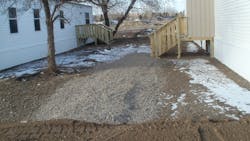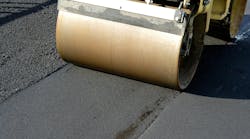Rolled Gravel Paver Solves Mud Problem for FEMA Trailer Residence
Flooding devastated much of North Dakota in the spring of 2011. Record flood levels on the Souris River (or Mouse River) left 11,000 Minot, N.D., residents homeless.
The Federal Emergency Management Agency (FEMA) identified 2,046 families in need of temporary housing. Nearly 670 of these families were housed at group sites like the Virgil Workman Village near Minot, which has 599 temporary housing units that were built in three phases.
FEMA rushed to get these families onto the site on the southeast edge of Minot, but had a multitude of logistical and design problems to overcome. FEMA, in a partnership with the U.S. Army Corp of Engineers (USACE), had to figure out how to get residents from their cars to their trailers without getting their shoes too dirty from the muddy ground.
Stable Solution
Breaking ground at the site in November posed many difficulties, one of which was the cold temperature, which peaks at an average of 37º. Pouring asphalt or concrete in these conditions is next to impossible. FEMA and USACE solved this problem by using a flexible gravel pavement system that rolls out. The system, called Gravelpave2, is an aggregate containment structure made from interconnecting plastic rings connected on a fabric-backed grid. The system is placed on a base course and filled with gravel. The system provided a stable, paved surface for residents to get from their parking areas to their trailers with minimal collection of mud and dirt on their shoes.
Gravelpave2 was installed quickly and was integral in getting the residents into temporary homes much faster than asphalt and concrete installations would have. In fact, the two phases of installation––a total of 84,000 sq ft––took only two days. FEMA employees worked quickly to unroll the product onto a prepared base, anchor it and fill it with gravel.
At 3.3 ft wide, the rolls provide a width suitable for a sidewalk from the parking area to the home. The rolls also have the ability to flex, so while the installation was done in low winter temperatures, the product will be able to adjust to the changes in freeze/thaw patterns of the North Dakota climate.
The Product
Gravelpave2 is classified as a flexible porous pavement, meaning water has the ability to flow through the system and into the ground, mimicking the natural water cycle of undisturbed land. Rain and snow melt that hits the system does not run off as it would with asphalt or concrete. Water runoff can cause flooding and pollution problems for humans, vegetation and wildlife, whereas porous pavement mitigates these problems.
Without this system, the families that were displaced by these floods would have had to trudge through mud and snow to access their temporary housing. Gravelpave2 was just the solution FEMA and USACE needed to address this problem.
When the manufacturer of the system, Invisible Structures Inc. of Golden, Colo., heard about the special needs for this site, it ceased all other production to focus solely on the residents of Minot.
“We really appreciate that they [Invisible Structures] could get the product made and delivered to us so fast,” said Clark Jandt of Brock-White Company, which supplied the system to FEMA. “There are a lot of people hurting up here.”


